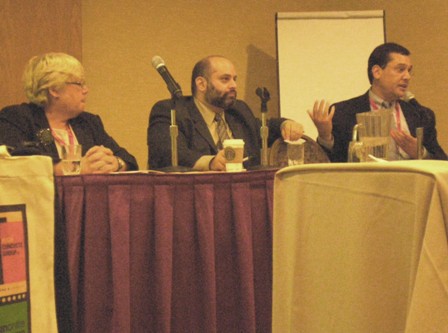Central Delaware Vision presented to AIA

Oct. 08
By Steven B. Ujifusa
For PlanPhilly
Penn Praxis Director Harris Steinberg participated on a panel titled “Creating a Civic Vision for the Central Delaware Waterfront,” Monday that was featured in the “Design on the Delaware” symposium sponsored by the Philadelphia AIA chapter. Also on the panel were Sandy Salzman, Director of the New Kensington Community Development Corporation (NKCDC) and Nando Micale of the design firm Wallace Roberts & Todd (WRT).
The panel discussed how during the past year, the city has relied upon Penn Praxis – as the lead consultant – to engage community groups, design firms, developers, and city government in the Delaware River planning process. During his summary of the history of the project, Steinberg highlighted how Penn Praxis has engaged the press, specifically the Philadelphia Inquirer and Daily News, to keep the planning process open and transparent. The end goal, he stated, was to “create a new paradigm involving robust civic dialogue.”
One timely item that came up for discussion was architectural critic Inga Saffron’s column last week in The Inquirer. In Saffron’s words, “a slew of developers launched what is shaping up as a gloves-off campaign to scuttle an eminently sensible proposal to extend the existing city street grid down to the edge of the Delaware River.”
On that note, Micale of WRT highlighted how the current vision calls for extending the street grid past Delaware Avenue, making this now-crowded thoroughfare an “armature” for future mixed use development, not just a corridor for big box stores. He emphasized how the preliminary approach is not about buildings and plazas as it was in the past, but about streets and open space, a way to guide phased development in the future.
Salzman of NKCDC described how the Kensington neighborhood has worked with both WRT and Penn Praxis to create a community-based plan for their section of the Delaware, which extends from Frankford Avenue north to Pulaski Park. One of the community’s key principles was to reconnect the neighborhoods physically to the Delaware River. The NKCDC identified four potential gateways to the river, at Frankford Avenue, Columbia Avenue, Aramingo/Girard Avenues, and Allegheny Avenue, and expressed a strong desire to improve Pulaski and Penn Treaty Parks.
During the question and answer session, Steinberg emphasized that it should be the City Planning Commission, not Penn Praxis, which runs future planning processes using strong civic engagement. “Whether official Philadelphia will seize this approach, we don’t know,” Steinberg concluded. When asked by one architect what he felt the plan’s biggest snag will be, Steinberg answered, “Our biggest worry is that it will be back to politics as usual, in which private conversations in back rooms determine how things really work out.”
Following the panel, Robert Keppel of Cope Linder Architects said, “the process is unique and enlightened, especially since the University of Pennsylvania is leading it, even if it is just this one time. I hope these methods could be a permanent activity on the City Planning Commission.”
WHYY is your source for fact-based, in-depth journalism and information. As a nonprofit organization, we rely on financial support from readers like you. Please give today.



